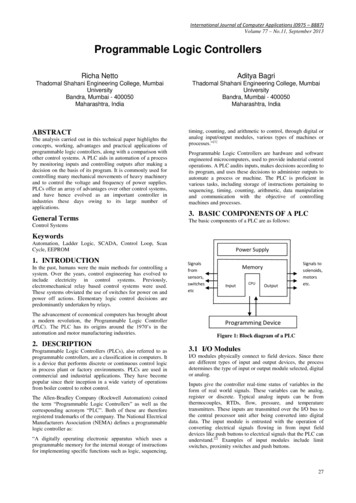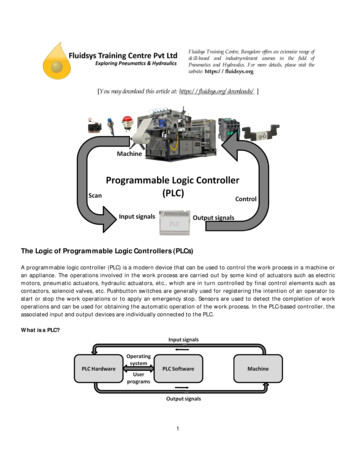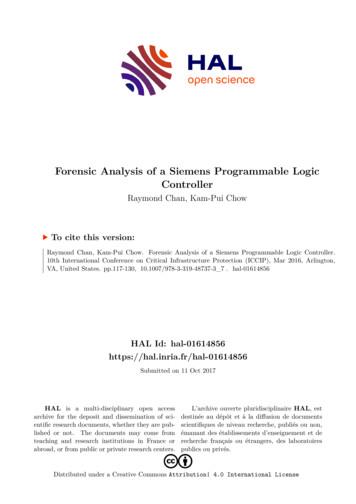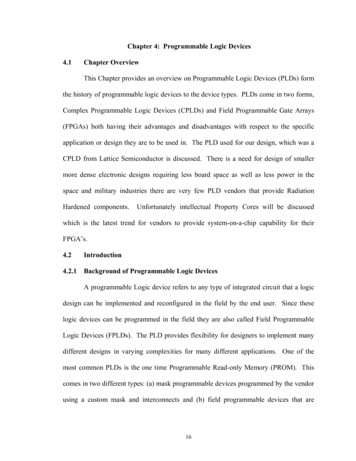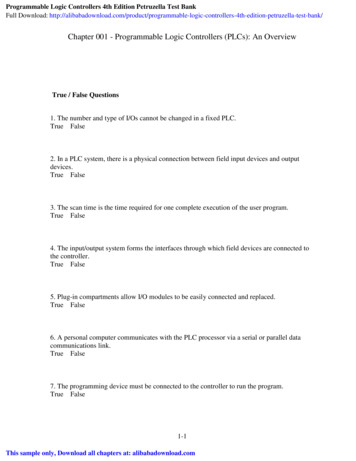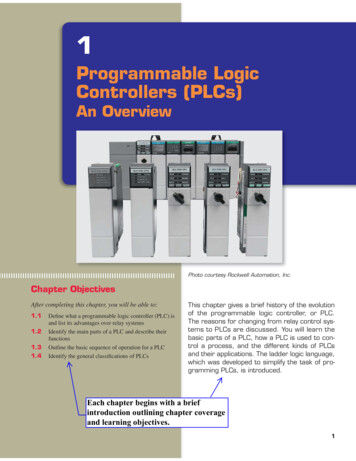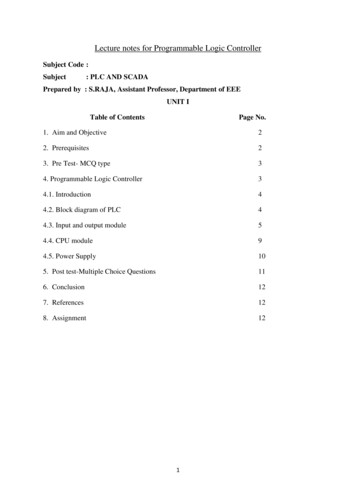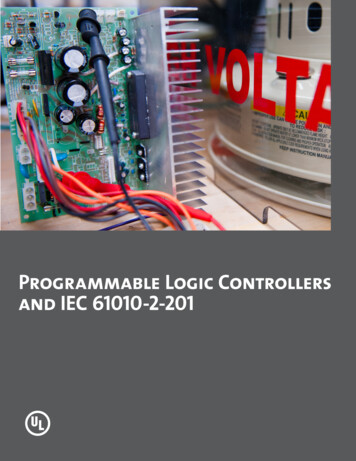
Transcription
Programmable Logic Controllersand IEC 61010-2-201
Programmable Logic Controllers and IEC 61010-2-201From their initial introduction in the late 1960s, programmable logiccontrollers (PLCs) have revolutionized the operation of electromechanicalmachinery and equipment.The widespread use of PLCs today is essential to the operation of all types of productionequipment, especially equipment used in modern industrial facilities. Easily adaptableto automating a wide range of tasks, PLCs make it possible to achieve increasedproduction efficiencies in a safe and cost-effective manner.Numerous efforts have been undertaken over the past few years to harmonize globalPLC requirements to reduce the regulatory compliance burden on manufacturersseeking worldwide market access. The most recent effort to harmonize technicalrequirements is represented by the 2013 publication of IEC 61010-2-201, Safetyrequirements for electrical equipment for measurement, control and laboratory use –Part 2-201: Particular requirements for control equipment. When used in conjunctionwith IEC 61010-1, Safety requirements for electrical equipment for measurement controland laboratory use – Part 1: General requirements, this standard addresses the specificsafety requirements of PLCs and other devices used in industrial automation, and willserve as the basis for the certification of PLCs beginning in April 2016.This UL white paper provides an overview of PLC requirements as presented in IEC61010-2-201, and the technical changes that PLC manufacturers must address inthe certification of new and modified PLC designs. Beginning with a brief historyof standards applicable to industrial control equipment, the paper discusses thebackground and structure of the IEC 61010 series of standards and their nationalequivalents. The white paper then takes a detailed look at the new and revised technicalrequirements of IEC 61010-2-201, and concludes with information about timelines fortransitioning to the new standard.Industrial Automation and the Standards ShortfallIndustrial automation technologies have dramatically transformed the business ofmanufacturing around the world. Today, manufacturers increasingly rely on automationto reduce production costs and increase production efficiencies. Automated industrialprocesses have also helped manufacturers achieve more consistent product quality,resulting in more reliable products in the marketplace. And, in many cases, industrialautomation has contributed to a reduction in workplace deaths and injuries byminimizing worker exposure to potentially dangerous conditions.page 2
Programmable Logic Controllers and IEC 61010-2-201In recent years, the combination of newstandards intended for use with industrialproduct group, and will strongly supportand advanced industrial automationautomation systems and equipmentproduct acceptance by regulators aroundtechnologies with complex controlunder the scope of its internationalthe world.systems has facilitated the furthersafety certification scheme, the IECEEintegration of formerly separate andCB Scheme. Specifically, it created adistinct aspects of the production process.new product standards category, INDATFrom the receipt of raw materials, through(industrial automation technology),the material handling, production andintended to include all standards directlypackaging processes, and ending withrelated to products used in industrialthe shipment of final products, a fullyautomation applications.integrated factory can achieve evengreater efficiencies and cost savings thana comparably advanced facility just 10The IEC also formed a new joint workinggroup (JWG) as a mechanism to supportyears ago.the development of more in-depthAt the same time, the integration ofof technology to industrial automationnumerous and diverse technologiesprocesses. Comprised of participants fromrelying on a high degree ofIEC Technical Committee (TC) 65 and TCinterconnectivity has significantly66, the formation of JWG 13 also helped tocomplicated the design and developmentcentralize the IEC’s oversight of applicableof new industrial automation systemsindustrial automation equipmentand equipment. One factor contributingstandards. JWG 13 is now responsibleto these complications has been thefor evaluating existing industrialrelatively slow pace at which applicableautomation equipment standards, andstandards have changed to addressaddressing gaps in safety coverage eithernew technologies and performanceby modifying existing requirements orexpectations for industrial automationdeveloping new standards.equipment. In many cases, these delayshave resulted in overlapping or conflictingtechnical requirements, as well asinadequate attention to larger safety andsecurity concerns attributable to entiresystems and the environment in whichtechnical expertise in the applicationThese and other efforts by the IEC aswell as national standards bodies andcertification organizations are expectedto result in more globally-consistenttechnical requirements for all types ofthey operate.industrial automation equipment andIn response to requests fromapproach will help to streamline themanufacturers of industrial automationtesting and certification process for newtechnologies, the Internationalindustrial automation technologies.Electrotechnical Commission (IEC) beganFurther, an internationally recognizeda major initiative in 2011 to address thesegroup of standards for industrialconcerns. Following an extensive internalautomation equipment is an essentialreview process, the IEC determinedrequirement for the application of thethe need to revamp its approach toIECEE’s CB Scheme to this importantpage 3systems. A consistent standardizationPLCs and IEC 61010-2-201An essential element of nearly every typeof industrial automation technology, PLCshave previously been subject to differentstandards with divergent technicalrequirements. IEC 61131-2, Programmablecontrollers—Part 2: Equipmentrequirements and tests, has providedthe primary technical requirements forPLCs in the European Union (EU) and inmany other countries around the world.However, the U.S. and Canada haveemployed different standards to evaluatePLCs, with UL 508, the Standard for Safetyof Industrial Control Equipment applicablein the U.S., and CAN/CSA-C22.2 No. 142,Process Control Equipment, applicablein Canada.While the technical requirements of theseU.S. and Canadian PLC standards weregenerally consistent with each another,they differed in significant ways fromIEC 61131-2. The key differences couldbe found in creepage and clearancedistances, required protection types andthe classification of loads, e.g., HP ratingvs. AC-3, or pilot duty rating vs. AC-1. Theseand other technical differences resultedin conflicting testing requirements forPLC manufacturers seeking to achievecompliance with regulations in majorglobal marketsAs part of its revamped approach toindustrial automation standards, the IECpublished in February 2013 a new technicalstandard for PLCs, IEC 61010-2-201.
Programmable Logic Controllers and IEC 61010-2-201Developed for use in conjunction with IEC 61010-1 for the evaluation and certification ofPLCs, the new standard incorporates electrical safety requirements previously found inIEC 61131-2. Concurrent with the publication of IEC 61010-2-201, the European Committeefor Electrotechnical Standardization (CENELEC), released EN 61010-2-201, a harmonizedversion of the standard applicable to PLCs sold or imported into the EU.The move toward globally harmonized requirements for PLCs continued in January 2014,when UL published UL 61010-2-201, to be used in conjunction with UL 61010-1 for U.S.certification of PLCs. A short time later, in April 2014, CAN/CSA-C22.2 No. 61010-2-201,a harmonized version of IEC 61010-2-201, for the certification of PLCs in Canada waspublished. Both the UL and CSA harmonized standards have been directly adopted fromIEC 61010-2-201 and include no national deviations.The publication of IEC 61010-2-201 and equivalent versions of the standard in theEU, the U.S. and Canada have now resulted in a single set of harmonized technicalrequirements that are broadly applicable to PLCs regardless of where they aremanufactured or sold. This change will significantly reduce design challenges for PLCmanufacturers as well as eliminate the need for duplicate testing to meet regulatoryrequirements in key target markets.Scope and New Requirements of IEC 61010-2-201 for PLCsIEC 61010-2-201 is a particular standard under the IEC 61010 series of industrialautomation standards that specifically addresses safety requirements and relatedverification tests for PLCs as well as a variety of other types of industrial controlequipment. Specific types of control equipment covered under the scope of thestandard include: Programmable controllers (PLCs and programmable automation controllers, PACs) Components of distributed control systems (DCSs) Components of remote input/output (I/O) systems Industrial computers, as well as programming and debugging tools (PADTs) Human-machine interfaces (HMIs) Stand-alone power supplies Any other type of product that performs the function of control equipment and/or itsassociated peripheral devicesThe specific technical requirements for PLCs detailed in IEC 61010-2-201 differ fromthose in IEC 61131-2, UL 508 and CAN/CSA-22.2 No. 142 in a number of key aspects.Some of the most notable new and revised technical requirements include: Durability of marking—PLCs are now tested for the durability of markings whenexposed to cleaning materials or isopropyl alcohol. This is a new requirement.page 4IEC 61010-2-201 is primarilya safety standardand does not addressreliability, functionality orperformance requirements,nor any other propertiesnot directly related to thesafety of the equipment.The standard also does notinclude any mechanicalor environmentalrequirements related tooperation, transport orstorage of equipment,issues which continueto be addressed in theIEC 61131 series. Finally,IEC 61010-2-201 doesnot directly addressrequirements thatmay be applicableregarding functionalsafety, electromagneticcompatibility or protectivemeasures applicableto equipment used inexplosive atmospheres.
Programmable Logic Controllers and IEC 61010-2-201 Double insulation—Under IECincluding motors, capacitors, mainsin IEC 61010-2-201, manufacturers seeking61010-2-201, all accessible parts musttransformers, interlocks and otherPLC certification will also be expected tobe separated from any hazardous partcomponents. Current PLC standardsmeet the general safety requirementsby two levels of protection. Currentin the U.S. and Canada do not call outdetailed in IEC 61010-1.PLC standards in the U.S. and Canadaspecific components for testing underrequire only a single level of protection.single fault conditions. Protection against mechanical Enclosures—UL 61010-2-201hazards—IEC 61010-2-201 requiresincorporates specific requirements forevaluation for specific mechanicalenclosures and materials within thehazards, including sharp edges andstandard. In addition, fire enclosuresmoving or removable parts, as well asand materials involving a fire hazardthe risk of equipment instability or fall.must have a minimum V-1 flameIn current PLC standards, protectionrating. For PLCs that form a partagainst mechanical hazards associatedof an end-product enclosure, suchwith enclosures is generally addressedas a panel-mounted PLC, it may bewith specific construction requirements,necessary to apply the environmentaland by references to other standards.ratings specified in UL 50E, the Risk assessment for mechanicalhazards—In certain circumstances, IEC61010-2-201 requires a risk assessmentStandard for Safety of Enclosures forElectrical Equipment, EnvironmentalConsiderations.procedure to evaluate each hazard forIn addition to demonstrating complianceseverity, probability of exposure andwith the technical requirements specifiedpossibility of avoidance. The outcomeof this assessment determines theappropriate protective measures thatmust be applied to mitigate identifiedhazards. This is a new requirement. Production line testing—Additionaltesting of production line productsamples is required. New required testsinclude protective earth, voltage testingand floating circuits testing. For voltagetesting, IEC 61010-2-201 uses differentvalues than those found in the currentstandards. The floating circuits test is anew requirement under the standard,should a PLC have a floating circuit. Single fault testing—A number ofspecified components are subject totesting under single fault conditions,page 5Transition Time Lines and OtherConsiderationsIn most jurisdictions, April 1, 2016, isthe target date for transitioning to therequirements of IEC 61010-1 and IEC61010-2-201. In the EU, presumptionof conformity with the essentialrequirements of the EU’s Low VoltageDirective (2006/95/EC) mandatesthat PLCs comply with the technicalrequirements of EN 61010-1 and EN61010-2-201 (the EU’s harmonized versionsof IEC 61010-1 and IEC 61010-2-201)beginning on that date. April 1, 2016corresponds with the published Dateof Withdrawal of EN 61131-2, the EU’sharmonized equivalent of IEC 61131-2 andthe current PLC safety standard in the EU.
Programmable Logic Controllers and IEC 61010-2-201In the U.S., UL has established a transition plan to the new PLC standards that alignswith that of the EU. As of April 1, 2016, UL will no longer accept new submittals forapproval of PLCs to either UL 508 or UL 61131-2. Instead, new applications for Recognitionor Listing to UL standards will be reviewed according to the requirements of UL 61010-1and UL 61010-2-201.PLC certifications issued in accordance with the requirements of UL 508 or UL 61131-2prior to April 1, 2016 will remain in effect after that date. UL will also allow testing ofalternate constructions of currently Recognized or Listed products to the requirementsof UL 508 or UL 61131-2 after April 1, 2016.As of this writing (August 2015), Canada has not announced a date for the transition toCAN/CSA 22.2 No. 61010-1 and CAN/CSA 22.2 No. 61010-2-201. Instead, it is expected thatCanada will continue to permit the use of PLCs certified to CAN/CSA 22.2 No. 142 andCAN/CSA-E61131-2 (the harmonized equivalent of IEC 61131-2), as well as PLCs certified tothe new standards. However, this situation is subject to change, and it is recommendedthat manufacturers investigate possible changes in advance of scheduled testing.Summary and ConclusionUL has also published“Frequently Asked Questionsfor the Transition fromUL 508 to UL 61010-1 andUL 61010-2-201,” whichaddresses a number ofadditional issues of interestto manufacturers whoseproducts are currently UL508 listed or recognized. Thishelpful guide is availableat ion-from-ul-508ul508c-toiec-based-standards?The pending adoption of IEC 61010-1 and IEC 61010-2-201 as the basis for the approval ofPLCs and other types of industrial control equipment is likely to create some challengesin the short term. Manufacturers will need to adapt existing and planned PLC designsto the new requirements, and prepare for more thorough and rigorous testing of theirproducts. At the same time, the acceptance by regulators of globally harmonizedrequirements for PLCs will significantly ease the testing and certification burden, reducecompliance-related costs and allow PLC manufacturers to more quickly gain legal accessto important markets without the need for additional testing.UL has extensive experience in industrial control systems and equipment as well asmost industrial automation technologies, and offers a complete suite of safety testingand certification services for PLCs. In addition to testing PLCs for compliance with U.S.,Canadian and EU harmonized equivalents of IEC 61010-1 and IEC 61010-2-201, UL is alsoa recognized CB testing laboratory (CBTL) under the IECEE’s CB Scheme, offering a singlesource for testing and approval required by more than 50 additional countries aroundthe world.For more information about UL’s services for PLCs, contact Steven Brown atSteven.A.Brown@UL.com, or John Kovacik at John.R.Kovacik@UL.com. 2015 UL LLC. All rights reserved. This white paper not be copied or distributedwithout permission. It is provided for general information purposes only and isnot intended to convey legal or other professional advice.page 6
Programmable Logic Controllers and IEC 61010-2-201 Double insulation—Under IEC 61010-2-201, all accessible parts must be separated from any hazardous part by two levels of protection. Current PLC standards in the U.S. and Canada require only a single level of protection. Protection against mechanical hazards—IEC 61010-2-201 requires
